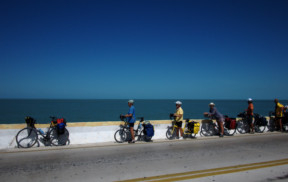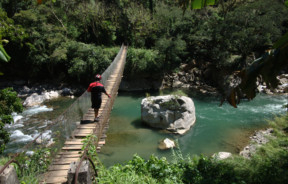
A bicycle tour in a food-loving country is a painful reminder that human beings have evolved to endure hardship. No, it’s not that people choose to ride when they could drive or be driven; it’s that they can actually — horror of horrors — gain weight on a bicycle tour, so fastidious is the body about squirrelling away every extra calorie it receives.
Mexico is a lot like India [my home country] in many ways, one of them being that food and beverages are sold on pretty much every corner. It’s all too easy to make your ride through Mexico a trip from snack to snack, meal to meal — with some sightseeing thrown in for luck. But with my two biggest passions being food and cycling, that suited me just fine.
So when I first wrote to Basil Yokarinis and Alexandra “Alix” Robinson of BikeMexico.com, I asked about the best tour from a culinary perspective. They recommended the “Mexican Three Week Odyssey” since it went through the Yucatan peninsula, a place whose largely Mayan cuisine doesn’t often make it out into the world.
The plan was to start in Merida, the capital of the state of Yucatan. Over the next three weeks we would cover about 1,100km, taking a south-westerly route to San Cristobal de las Casas, set high in the mountains of Chiapas state.
According to Basil and Alix, the trip could be divided into five parts: the colonial towns; Mayan ruins and cenotes of Yucatan; the Gulf of Mexico coast and its isolated shell beaches through the state of Campeche; the wetlands, birds and cacao-growing region of Tabasco; and finally the challenging climbing, beautiful scenery and indigenous peoples of Chiapas.
The food
The cuisine of the Yucatan peninsula has held on to its pre-Hispanic roots more than other parts of Mexico. Also consider that this is the native habitat of foods that are now so common, it’s easy to forget they were unknown to most of world till relatively recently: chillies, chocolate, turkey and corn.
While tamales or steamed corn dough cakes stuffed with meat are everywhere in Mexico, you see a particularly wide variety here, ranging from the custardy “strained” tamales of Yucatan to the grainier ones up in San Cristobal that remind me of idli [a South Indian dish]. Since turkey [pavo] is native, it doesn’t have to be the season for you to see it everywhere, notably as pavo en relleno negro — a sauce whose blackness suggests squid ink but involves roasted chillies — of which there’s a bewildering variety at the markets.
Then there’s conchinita pibil, that most famous of Yucatan dishes: the slow-roasted meat with achiote or ground annatto seeds. Poc chuc or grilled meat marinated in sour orange is another largely Mayan recipe from the region. Yucatecans are also proud of their sopa de lima — chicken or turkey broth with a good squeeze of one or two of the delicious local limes.
And since this is where corn, as we know, was born, you see it everywhere — in food [especially as tortillas, of course] and in various non-alcoholic drinks as well.
Big glass jars of ancient workingman potions are on carts and stalls everywhere, notably in Villahermosa. Pozol con cacao is slightly milky from the ground corn with a light cocoa taste from ground roasted cacao beans. Another drink, polvio, is made from toasted corn, and a third, tascalate, uses chocolate, ground pine nuts and the puzzlement of my palate, the savoury, dusty flavour of achiote.
The Mayan drink
But it’s in Tabasco state that cacao starts to really make an appearance; in the form of trees by the roadside, in drinks, roasted beans at shops, and as a bittersweet chocolate all grainy with sugar. The trip stops to tour two cacao plantations, one of them growing a special kind called criollo, which has an especially smooth flavour. The drinking chocolate produced at Hacienda la Joya has won awards in Paris as the best tasting in Mexico.
Drinking chocolate at this quality mixes into an intensely fruity drink that’s very little like the hot chocolate I’ve drunk up to now. The cacao fruit itself has a tangy taste and creamy texture, and the seed, from which chocolate is made, is bitter and unpalatable.
The plantation owner Doña Clarita led us around the plantation, and deftly cut up a fruit for us to taste. We even hand-ground some chocolate in the Mayan tradition — which we had the next day as a pre-ride drink. We raided the estate shop, buying cylinders of crumbly drinking chocolate, cocoa mass and cocoa butter. And not long after we loaded our panniers with these heavy goodies, we got to the mountains. I did not expect them to be so beautiful, or so steep.
We were now entering the home of the Zapatistas and had to be careful of taking photographs. Not just because of the members of the leftist revolutionary group though — most of the indigenous people here have a superstition against being photographed, and are known to tackle photographers and confiscate their cameras. We had some memorable picnic lunches in the mountains, stopping at dramatic outlooks and eating local cheese, bread and fruit as we looked out over the valley far below.
Though I’d ridden a lot in my then-home town of Los Angeles, it was my first bicycle tour and I was hooked. Riding a bicycle through a new country is the perfect way to immerse oneself in a new territory and watch it change its character, terrain, food and people. The pace is just right — you cover a good amount of ground, and yet are able to take in so many experiences that you’d just swish past in a bus or car. And the best bit is that if you are into food the way I am, you have an appetite all the time.
The tour
Visit BikeMexico.com for tour options. The tour described here has been temporarily discontinued, but there are many options that cover much the same ground. America is probably the cheapest place in the world to buy a good bicycle, so the best way to do one of these tours is to spin off a US visit. Carry a Spanish phrase book because almost nobody speaks English.
The bicycle
The tour guides have seen all kinds of bicycles — dedicated touring bikes, regular road or mountain bikes with a rear rack, recumbents, folding bikes. The bike will need to take two rear panniers and perhaps an extra bag that straps on top of the rack. Handlebar bags are always useful on tour. Ortlieb, Altus and Lone Peak are quality brands for bags, and Topeak or Bontrager are recommended budget brands.










